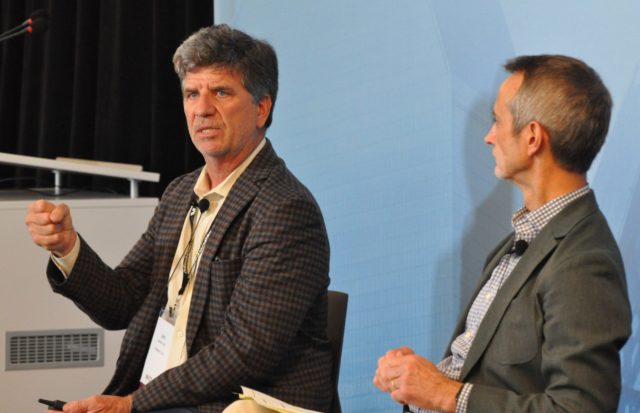
Jim Walton, President of JWalton LLC (left) with Polsinelli Healthcare M&A Co-chair Jonathan Henderson.
It is a daunting fact that as the 75 million members of the Baby Boomer generation need more caregiving support as they age, there will be an acute shortage of people to look after their needs. If we consider what each generation’s healthcare preferences are and how those preferences will inform healthcare and caregiving in the future, we can begin better planning for how best to handle these intersecting issues.
In a fireside chat at INVEST Digital Health in Dallas this week, Polsinelli Healthcare M&A Co-chair Jonathan Henderson and Dr. Jim Walton, President of JWalton LLC discussed the implications, what those healthcare preferences are and how they will impact care for future generations. In his presentation, Walton also remarked on his own journey as a physician, healthcare administrator and a longtime patient, taking years to recover from a broken neck.
“There’s going to be a shift in decision making,” Walton said. “Decision makers have a different point of view than the people they are making decisions for, and that tension is going to define the winners and the losers in the marketplace.”
Healthcare delivery preferences differ for multiple generations
In a slide presentation, Walton broke down each generation’s attitudes towards healthcare. The Silent generation, born between 1926-1945, prefer provider guidance and support and “benefit from engagement outside of the office. Baby Boomers prefer individualized care, according to Walton, who identifies as a Baby Boomer. They value provider opinions but conduct their own research. They benefit from interactions that promote dialogue, according to a slide that was part of Walton’s talk.
Generation X, on the other hand, tends to prefer providers who support independence.
Generation Y values efficiency and convenience, strong patient-provider connections, and benefits from tech-based access to healthcare. Both Gen Y and Z value telehealth.
“We have to think of healthcare as more integrative because that’s the kind of decision makers that are going to be helping [Baby Boomers] like me,” said Walton.
Walton added: “What we see is government-sponsored healthcare, the biggest purchaser of healthcare, has a vested interest in shifting the financial risk to the provider. We’re not there yet. We don’t have the technology or the infrastructure. But more importantly, we’re not integrated clinically. Care delivery is not seamless.”
Retail health
Retail Health organizations have made ambitious moves into primary care. Amazon purchased One Medical, Walgreens is a majority owner in Village MD and partially owns Summit Health-City MD. CVS Health acquired Oak Street Partners. In addition to these retailers, Kroger and Walmart all offer telehealth services across the country. CVS Health, Walgreens, Walmart, and Kroger provide retail health clinics for vaccinations and other services. Additionally, CVS Health and Walgreens are also active in the home health sector. CVS owns home health risk assessor Signify Health and Walgreens owns CareCentrix, a home health tech company. Each of them is likely to expand their services in the future and, depending on how they grow, could play a larger role in healthcare in the future.
Health disparities
Given the interest in telehealth from Generations X-Z, Walton expressed concerns about rural communities missing out on broadband-enabled telehealth.
Walton observed that the current landscape for health tech is creating health disparities not only in rural areas that lack reliable broadband access but would also exacerbate the challenging caregiving outlook Baby Boomers and other generations face. Add to that the reality that many adult children who will be helping to provide caregiving services for parents may live in a different state and juggle those responsibilities with a full-time job and families of their own.
Walton called for financial incentives for improving caregiving disparities in the coming years so that the government and private sector could bring thought leadership and innovation together to address these critical issues in healthcare. He also emphasized the need to simplify health tech solutions to improve engagement and adoption and cautioned not to lose sight of the value of a human touch from providers in care delivery.








